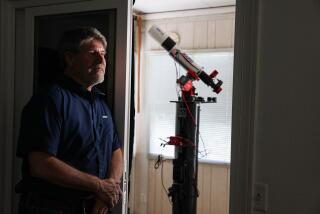Ben Mayer; Amateur Astronomer Invented Equipment for the Pros
- Share via
Ben Mayer, a successful interior designer for casinos and theaters by profession, and a remarkably accomplished amateur astronomer in his off-duty hours who uniquely photographed an exploding star with equipment he invented, has died. He was 74.
Mayer, who lived in Westlake Village, died Tuesday at UCLA Medical Center after a series of strokes, said his son, Quinn Mayer.
The German-born Mayer never set out to become an astronomer, but that discipline became his greatest passion and earned his greatest fame.
He published four books and patented a number of devices used by professional astronomers around the world.
He spoke frequently at stargazers conventions and in 1986 went to San Diego to urge the United Astrology Congress to return to historical practices of physically observing the stars. Mayer well knew that the first astronomers profited from thousands of years of observation of the firmament by astrologists who believed that the stars govern people and events.
“To me the word ‘amateur,’ which stems from the word ‘amore,’ from the word ‘love,’ is a delightful word,” Mayer told The Times in 1986, “and I think no place is it better used than in astronomy, where the amateur since the beginning of time has done truly meaningful and useful work, because he or she observes with no prejudice, because he has no brownie points to rack up. He doesn’t have to give a paper on Monday. He is a lover--he does it for love.”
Mayer, who spoke five languages, was educated at All Saints School of Art in Manchester, England, and the Royal College of Art in London. He immigrated to Los Angeles in 1949, married, built a house in Bel-Air and started a nearby business called Ben Mayer Design Inc.
The design business supported his hobbies--hunting, boating, water skiing, roaming the globe, photography and especially astronomy--until that avocation overtook the vocation. He turned over his company to son Quinn and devoted his full time to studying the stars and inventing apparatus to help.
Mayer followed and photographed 13 total eclipses around the world and, according to his son, was the first to record on color film all 108 of what are know as the Messier galactic objects.
The extraordinary amateur first attracted international astronomical attention in 1975 when he became the first person to produce a sequence of photographs of a nova--the explosion of a star--before, during and after the 36-hour event.
Pure serendipity, Mayer said. He was photographing the constellation Cygnus (also called the Northern Cross), searching for a meteor shower that wasn’t there. He didn’t even realize he had photographed the nova until three days later. When he first examined the photos and saw no meteor shower, he threw the pictures in the trash. But after the nova was observed in Japan, Mayer scurried back to the wastebasket.
No major telescope assisted Mayer in his coup. He made the 13-photo sequence with a 35-millimeter camera, a 50-millimeter lens and an exposure timer made from a lawn sprinkler. Moreover, he was taking the pictures from his roof in light-polluted Bel-Air.
Mayer patented his equipment and then donated it, along with the photographs, to the Smithsonian Astrophysical Observatory in Cambridge, Mass.
“The reason I did it is that I didn’t know I could do it,” Mayer told The Times in 1986, attributing part of his success as an astronomer to ignorance about the science’s limitations.
He also invented and patented Starframes and Stellaphanes, hand-held sky viewing systems used by astronomers around the world, and the gravity-driven Astrocompass to determine height above the horizon relative to time. Used with a Starframe or Stellaphane, the special compass provides stargazers easy-to-use windows to the sky in any latitude.
He also invented Problicom, a photo-comparing device, and the popular science toy called Starwatcher Decoder Kit.
Mayer wrote three books on his own--”Starwatch” in 1984, “Halley’s Comet Finder” in 1985 and “Astrowatch” in 1988. And with former Harvard astronomy professor William Liller, Mayer co-authored “The Cambridge Astronomy Guide: A Practical Introduction to Astronomy” in 1985.
Astronomer and author David Brin, in reviewing a spate of Halley’s comet books for The Times in 1985, noted that “The ‘Halley’s Comet Finder’ by Ben Mayer is one of the most helpful and entertaining.”
An asteroid was named for Mayer, and he was once designated “amateur of the year” by the Astronomical Society of the Pacific. The century-old society dubbed the guide that Mayer wrote with Liller the astronomy book of the year in 1986.
Mayer is survived by his wife of 50 years, Lucille, his son and two grandchildren, Shawn and Heather Mayer.
Services will be private, but the family said any memorial donations can be made to Project Astro, in care of the Astronomical Society of the Pacific, 390 Ashton Ave., San Francisco, CA 94112.
More to Read
Inside the business of entertainment
The Wide Shot brings you news, analysis and insights on everything from streaming wars to production — and what it all means for the future.
You may occasionally receive promotional content from the Los Angeles Times.










